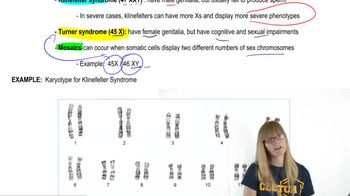What must be assumed in order to validate the answers in Problem 7?
Table of contents
- 1. Introduction to Genetics51m
- 2. Mendel's Laws of Inheritance3h 37m
- 3. Extensions to Mendelian Inheritance2h 41m
- 4. Genetic Mapping and Linkage2h 28m
- 5. Genetics of Bacteria and Viruses1h 21m
- 6. Chromosomal Variation1h 48m
- 7. DNA and Chromosome Structure56m
- 8. DNA Replication1h 10m
- 9. Mitosis and Meiosis1h 34m
- 10. Transcription1h 0m
- 11. Translation58m
- 12. Gene Regulation in Prokaryotes1h 19m
- 13. Gene Regulation in Eukaryotes44m
- 14. Genetic Control of Development44m
- 15. Genomes and Genomics1h 50m
- 16. Transposable Elements47m
- 17. Mutation, Repair, and Recombination1h 6m
- 18. Molecular Genetic Tools19m
- 19. Cancer Genetics29m
- 20. Quantitative Genetics1h 26m
- 21. Population Genetics50m
- 22. Evolutionary Genetics29m
22. Evolutionary Genetics
Phylogenetic Trees
Problem D.11
Textbook Question
In Island Melanesia and Polynesia, most mtDNA haplotypes are of Asian ancestry, whereas Y chromosome haplotypes are predominantly New Guinean. Provide a hypothesis for this sex-biased distribution.
 Verified step by step guidance
Verified step by step guidance1
Understand the biological basis of mtDNA and Y chromosome inheritance: mtDNA is maternally inherited, meaning it is passed down from mothers to their offspring, while the Y chromosome is paternally inherited, passed from fathers to sons.
Recognize that the observed pattern—Asian ancestry in mtDNA and New Guinean ancestry in Y chromosomes—suggests different migration or mating patterns for males and females in these populations.
Formulate a hypothesis that could explain this sex-biased distribution, such as a scenario where Asian women migrated and integrated into New Guinean male populations, leading to Asian mtDNA lineages and New Guinean Y chromosome lineages.
Consider historical or anthropological factors that might support this hypothesis, such as patrilocality (where women move to the husband's community), male-biased local residence, or differential migration routes for men and women.
Summarize the hypothesis by linking the genetic evidence to social or demographic behaviors that result in the observed pattern of Asian mtDNA and New Guinean Y chromosome haplotypes.
 Verified video answer for a similar problem:
Verified video answer for a similar problem:This video solution was recommended by our tutors as helpful for the problem above
Video duration:
3mPlay a video:
Was this helpful?
Key Concepts
Here are the essential concepts you must grasp in order to answer the question correctly.
Mitochondrial DNA (mtDNA) Inheritance
mtDNA is inherited exclusively from the mother, making it a useful marker for tracing maternal ancestry. Because it does not recombine, mtDNA haplotypes reflect maternal lineage and migration patterns over generations.
Recommended video:
Guided course

Organelle Inheritance
Y Chromosome Inheritance
The Y chromosome is passed from father to son, serving as a marker for paternal ancestry. Its haplotypes reveal male lineage and can show different migration or admixture patterns compared to maternal markers.
Recommended video:
Guided course

Human Sex Chromosomes
Sex-Biased Gene Flow and Migration
Sex-biased gene flow occurs when males and females contribute differently to the gene pool due to cultural practices like patrilocality or matrilocality, or historical migration events. This can lead to contrasting patterns in mtDNA and Y chromosome distributions.
Recommended video:
Guided course

Sex-Linked Genes
Related Videos
Related Practice
Textbook Question
517
views


